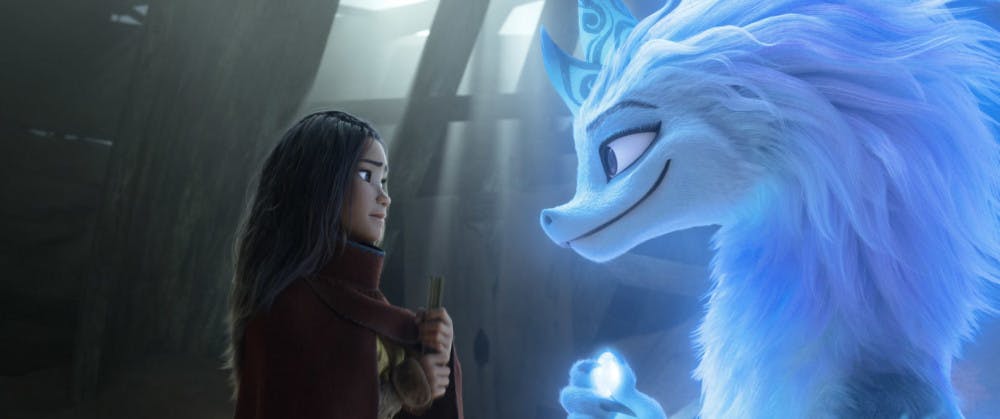Since 2013’s “Frozen,” Disney has demonstrated a conscious attempt at steering toward material with greater socio-political significance, shedding the archetypal characters of Western medieval romances and diversifying their stories. Who says the damsel in distress needs a dashing knight-errant? Who says she must be a princess passively awaiting, often in an accursed slumber, true love’s kiss?
In the case of Disney’s newest film, “Raya and the Last Dragon,” the damsel is Raya (voiced by Kelly Marie Tran), a fiercely independent Southeast Asian guardian of the dragon’s gem, a powerful ancient relic that wards off evil but also sows the seeds of discord among distrusting tribes.
Moments that at first appear to be Raya in distress more often than not turn out to be deliberate acts of deception. Raya cleverly subverts the tired damsel trope to distract her enemies from the development of her ambitious plan — to heal the land ravaged by Druun, a “mindless plague” that reduces people to terracotta statues.
When Raya is in actual need of aid, her eclectic fellowship, ranging from a rhyme-spitting dragon (voiced by Awkwafina) to a displaced “con-baby,” swoops in for the rescue. What follows is a formulaic adventure plot, where the protagonist overcomes obstacle after obstacle with little difficulty, culminating in a predictably climactic battle under the auspices of an overworked moral lesson on trust and reconciliation.
While “Raya and the Last Dragon” suffers from trite plot progression and an unsurprising end, there is an undeniable charm to the film’s colorful characters. Reminiscent of Mushu in “Mulan,” Awkwafina’s Sisu, the “last dragon” who is fundamental to Raya’s world-saving mission, plays the entertaining sidekick to the grim-faced heroine. Cracking jokes and witty, anachronistic asides in her iconic scratchy voice, Awkwafina shines in the role, imbuing her character with authenticity through her casual naivete.
The rest of the supporting characters are equally memorable: Boun (voiced by Izaac Wang), a young boy with the self-assured charisma of a seasoned congee chef, Tong (voiced by Benedict Wong), a bearish ruffian with a heart of gold and Little Noi (voiced by Thalia Tran), a cherubic-looking infant pickpocket exploiting the concern of passersby as she bawls unattended in an alley. Along with Sisu, these supporting characters form the film’s emotional anchor, reminding the audience of the countless casualties caused by Druun and the high stakes behind Raya’s mission.
Another distinguishing aspect of the film is its impressive world-building and fastidious attention to detail. From the tropical greens and blues of the prosperous Heart to the floating night market scene in Talon, “Raya and the Last Dragon” grounds its vision in Southeast Asian beauty through environment and cuisine. Though the film’s two-hour runtime hardly grants the opportunity for an in-depth exploration of the fantasy realm’s multiple lands, its concise shots combined with beautifully choreographed action sequences are a pleasure to behold.
Following the arrivals of “Coco” and “Moana,” viewers of “Raya and the Last Dragon” might suspect Disney’s attempt at multiculturalism as a plea for relevancy — another addition to the growing collection of animations that serves as part of a corporate strategy to appease an international audience and generate more profit. But, considering Disney makes corporate cash grabs with or without a globalized cognizance towards cultural and racial diversity, this film serves both as a family-friendly profit generator and a high-profile homage to Southeast Asian nations where its inspiration was derived, including Laos, Indonesia, Thailand, Vietnam, Cambodia, Singapore and Malaysia.
Ultimately, Disney growing more attuned to gender and race politics is better than an adherence to the antiquated princess-needs-savior trope. Raya, a sword-wielding savior of herself, a non-princess from a non-Western culture, sends a considerably more empowering message than that of a fourteen-year-old girl lying in a glass coffin surrounded by seven mournful dwarves.

ADVERTISEMENT




